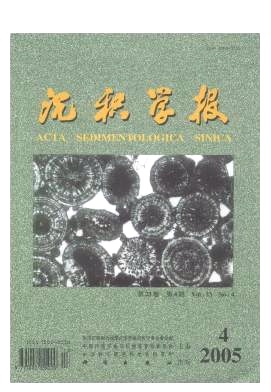HTML
| [1] | 1 刘东生. 黄土与环境[M].北京:科学出版社,1985.1-412. 2 An Z S,Kutzbach J E,Prell W,Porter S C. Evolution of Asian mosoons and phased uplift of the Himalaya - Tibetan plateau since Late Miocene times[J].Nature,2001.62-66. 3 岳乐平,杨利荣,李智佩. 西北地区干枯湖床沉积粒度组成与东亚沙尘天气[J].沉积学报,2004,(02):325-331. 4 Pan BT,BurbankD,WangYX. A900 k.yrecord of strath terrace formation during glacial-interglacial transitions in northwest China[J].Geology,2003,(11):957-960. 5 鹿化煜,安芷生. 黄土高原红粘土与黄土古土壤粒度特征对比-红粘土风成成因的新证据[J].沉积学报,1999,(02):226232. 6 Rea D K,Snoeckx H,Joseph L H. Late Cenozoic eolian deposition in the North Pacific: Asian drying,Tibetan uplift,and cooling of the northern hemisphere[J]. Paleoceanography,1998,(03):215-224. 7 Guo Z T,Ruddiman W F,Hao Q Z. Onset of Asian desertification by 22 Myr ago inferred from loess deposits in China[J]. Nature,2002,(14):159-163. 8 Chen J,An Z,Head J. Variation of Rb/Sr ratios in the loess-paleosol sequences of Central China during the last 130,000 years and their implications for monsoon paleoclimatology[J].Quaternary Research,1999. 215-219. 9 马锋,刘立,王安平. 图门江下游沙丘粒度分布与石英表面结构研究[J].沉积学报,2004,(02):261-266. 10 Zhou L P,Oldfield F,Wintle A G. Partly pedogenic origin of magnetic variations in Chinese loess[J].Nature,1990.1-3. 11 XiaoJL,PorterSC,AnZS. Grain size of quartz as an indicator of winter monsoon strength on the Loess Plateau of central China during the last 130,000 yr[J].Quaternary Research,1995.22-29. 12 Ding Z L,Yu Z W,Rutter N W,Liu T S. Towards an orbital times scale for Chinese loess deposits[J].Quaternary Science Reviews,1994.1339-5713. 13 鹿化煜,安芷生. 洛川黄土粒度组成的古气候意义[J].科学通报,1997,(01):66-69. 14 鹿化煜,安芷生. 黄土高原黄土粒度组成的古气候意义[J].中国科学D辑,1998,(03):278-283. 15 赵景波. 黄土的本质与形成模式[J].沉积学报,2003,(02):198-204. 16 成都地质学院陕北队. 沉积岩(物)粒度分析及其应用[M].北京:地质出版社,1976.90-100. 17 Flint R F. Glacial Geology and the Pleiocene Epoch[Z].1955.175-187. 18 Pye K. Aeolian Dust and Dust Deposits[M].Academic Press,1987.68. 19 Zarate M,Blasi A. Late Pleistocene-Holocene Eolian Deposits of the Southern Buenos Airs Province,Argentina: A preliminary model[J].Quaternary International,1993.15-20. 20 孙继敏,刘东生,丁仲礼. 五十万年来毛乌素沙漠的变迁[J].第四纪研究,1996,(04):359-365. 21 靳鹤龄,董光荣,苏志珠. 全新世沙漠-黄土边界带空间格局的重建[J].科学通报,2001,(07):538-543. 22 丁仲礼,孙继敏,刘东生. 联系沙漠-黄土演变过程中耦合关系的沉积学指标[J].中国科学,1999,(01):82-87. 23 孙继敏. 中国黄土的物质来源及其粉尘产生的机制与搬运过程[J].第四纪研究,2004,(02):175-183. 24 邱新法,曾燕,缭启龙. 我国沙尘暴的时空分布规律及其源地和移动路径[J].地理学报,2001,(03):316-322. 25 孙东怀,鹿化煜,David Red. 中国黄土粒度双峰分布及古气候意义[J].沉积学报,2000,(03):327-335. 26 Prins M A,Postma G,Weltje G. Controls on the terrigenous sediment supply to the Arabian Sea during the late Quaternary: The Markran continental slope[J].Marine Geology,2000,(3-4):351-371. 27 Prins A,Vandenberghe J,Weltje G J. Palaeoclimate signals in loess size distributions[A].Particle Size to Sediment Dynamics,2004.123-125. 28 张小曳. 亚洲粉尘的源区分布、释放、输送、沉降与黄土堆积[J].第四纪研究,2001,(01):29-40. 29 Cen F H,Bloemendal L,Feng Z D. East Asian monsoon variations during oxygen isotope stage 5: evidence from the northwestern margin of the Chinese loess plateau[J].Quaternary Science Reviews,1999.1127-1135. 30 Ding Z L,Derbyshire E,Yang S L. Stacked 2.6-Ma grain size record from the Chinese loess based on five sections and correlation withthe deep-see δ18 O record[J].Paleoceanography,2002,(03):725-756. 31 汪海斌,陈发虎,张家武. 黄土高原西部地区黄土粒度的环境指示意义[J].中国沙漠,2002,(01):21-26. 32 张德二,陆风. 我国北方的冬季沙尘暴[J].第四纪研究,1999,(05):441-447. 33 王式功,王金艳. 中国沙尘天气的区域特征[J].地理学报,2003,(02):193-200. 34 哈斯,王贵勇,董光荣. 沙丘背风侧气流及其沉积类型与意义[J].沉积学报,2001,(01):96-100. 35 鹿化煜,安芷生. 前处理方法对黄土沉积物粒度测量影响的实验研究[J].科学通报,1997,(23):2535-2538. 36 Kohfeld K E,Harrison S P. Glacial-interglacial changes in dust deposition on the Chinese Loess Plateau[J].Quaternary Science Reviews,2003,(03):1859-1878.doi:10.1016/S0277-3791(03)00166-5. 37 Blott S,Pye K. Gradistat: grain size distribution and statistics package for the analysis of unconsolidated sediments[J].Earth Surfaces and Landforms,2001.1237-1248. |






 DownLoad:
DownLoad: